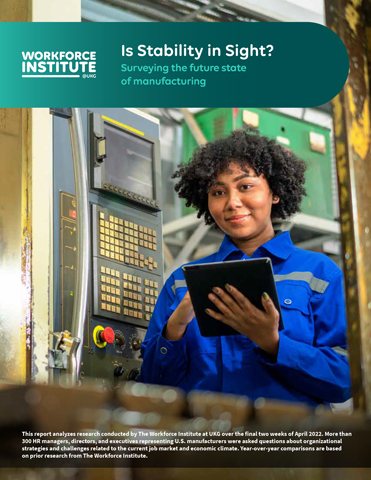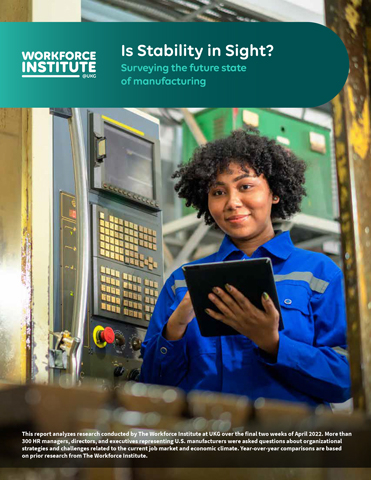LOWELL, Mass., & WESTON, Fla.--(BUSINESS WIRE)--According to a newly released survey of manufacturing HR leaders by The Workforce Institute at UKG, 4 in 5 U.S. manufacturers are having difficulty keeping up with production demands due to increased supply constraints and ongoing labor shortages amplified by today’s competitive job market. Although a skilled-labor gap has plagued the sector for decades, 87% of the 300 manufacturing HR leaders surveyed feel its impact “more than ever.” Read full research here.
“Volatile demand has been a hallmark of the pandemic era, affecting 83% of manufacturers in the past year alone. This variability exacerbates staffing troubles, impacting people’s livelihoods and wellbeing,” said Kylene Zenk, director of the manufacturing practice at UKG. “Looking ahead to positively manifest the future state of manufacturing, more concrete strategies and people-first tools are needed on the frontlines to forecast demand and satisfy the needs of all employees, with respect to real-time market conditions.”
Key Insights:
- Manufacturers estimate production lines are under- or overstaffed 62% of the time, on average, leaving just 11 days per month when facilities are staffed appropriately.
- Supply constraints and the skilled-labor shortage impact nearly every manufacturer’s bottom line, as 2 in 3 labeled these financial impacts “mild” or “moderate,” while close to 1 in 3 described them as “severe.”
- Although production demand holds strong, the number of hourly shifts worked in manufacturing has degraded slowly but steadily since February 2022, a result of both the widening labor gap and a shortage of parts and materials forcing plants to cut employee hours.
The Labor Struggle is Real
A year ago, fewer than 2 in 3 manufacturers (63%) were struggling to fill critical labor gaps and production lines were understaffed 24% of the time, on average. Today, as 87% struggle to fill critical labor gaps, manufacturers report frontline facilities are understaffed 38% of the time, while a quarter said they were understaffed at least half the time in April 2022 — up from 14% in 2021.
An Exceedingly Tight Labor Market Drives Up Employee Exits, Ghosting
Behind labor and supply issues, employee absence, turnover, and quality issues hit manufacturers’ bottom lines hardest in the past 12 months, with 29% calling these impacts “severe.” Compared with 2021, at least half of respondents said employee resignations, manager departures, and retirements all increased, while employee ghosting — e.g., when an employee unexpectedly skips a scheduled shift or suddenly stops coming in to work — also gained traction. And, while demand for workers is high, more than 2 in 3 manufacturers (68%) terminated employees in April 2022 citing intolerable attendance issues.
Getting Retention Right Requires a People-Centric Approach
Half of HR leaders surveyed said their organizations increased wages for existing workers in the past year, while many raised starting pay for hourly employees (70%) and frontline managers (65%), too. More manufacturers today also offer remote-work options (44%) and flexible schedules (40%).
The majority of manufacturing organizations are working to actively enhance workplace culture (91%) and doing more today to support employee wellbeing than 12 months ago (89%). They have also committed to several employee-centric goals among their top-five priorities for the year ahead: (1) employee safety and wellbeing, (2) strengthening the supply chain, (3) diversity, equity, inclusion, and belonging, (4) recruitment, and (5) retention.
“Caring is the foundation of strong leadership. Attracting new talent is critical in this moment, but taking care of existing people is good for your bottom line in good times and in bad,” said Zenk. “People have more choices than ever when it comes to employment and what matters to them is changing. Initiatives that make all employees feel safe, heard, and valued is key to retaining your best people and unlocking greater business outcomes.”
Is Employment Stability in Sight for U.S. Manufacturing?
HR leaders in manufacturing are becoming more innovative in hiring and diversifying candidate pools to offset difficulty finding the right people with the right match of manufacturing skills, certifications, and experience, with 63% increasing employee headcount year over year. Nearly half rehired former employees — i.e., boomerangs — as well as people reentering the workforce after a career break (both 48%), and 38% hired people with no manufacturing experience at all.
“If you can offer training and development or can tailor a job to meet candidates’ flexible qualifications, filling open headcount becomes more realistic in a tight labor market,” said Zenk.
About The Workforce Institute at UKG
The Workforce Institute at UKG provides research and education on critical workplace issues facing organizations around the world. By bringing together a global consortium of HR and workforce management thought leaders, the think tank is uniquely positioned to empower organizations with practical ideas for optimizing the 21st-century workplace while also providing an important voice for employees, including frontline and hourly workers. Founded in 2007, The Workforce Institute focuses its research and education — including books, podcasts, surveys, blogs, and its annual list of workplace predictions — on balancing the needs and desires of diverse employee populations with the interests of organizations in order to manage absenteeism, fight burnout, develop equitable work schedules, and build strong leaders, all to drive inspired performance.
About UKG
At UKG, our purpose is people. As strong believers in the power of culture and belonging as the secret to success, we champion great workplaces and build lifelong partnerships with our customers to show what’s possible when businesses invest in their people. Born from a historic merger that created one of the world’s leading HCM cloud companies, our Life-work Technology approach to HR, payroll, and workforce management solutions for all people helps more than 70,000 organizations around the globe and across every industry anticipate and adapt to their employees’ needs beyond just work. To learn more, visit ukg.com.
Survey Methodology
Research findings are based on an industry survey conducted by InnovateMR on behalf of The Workforce Institute at UKG from April 20 to 28, 2022, to understand the organizational challenges facing U.S. manufacturers related to the current job market and economic climate. Responses were collected from 308 HR leaders who work for a U.S. manufacturing company, including HR directors (65%), HR executives (19%), HR managers (14%), and other hiring decision-makers (2%). Seventy percent of respondents said their company’s annual revenue is more than $250 million, and 8% said they work for a U.S.-based multinational organization.
Copyright 2022 UKG Inc. All rights reserved. For a full list of UKG trademarks, please visit ukg.com/trademarks. All other trademarks, if any, are property of their respective owners. All specifications are subject to change.
Follow UKG on Facebook, Instagram, LinkedIn, Twitter, and YouTube.




